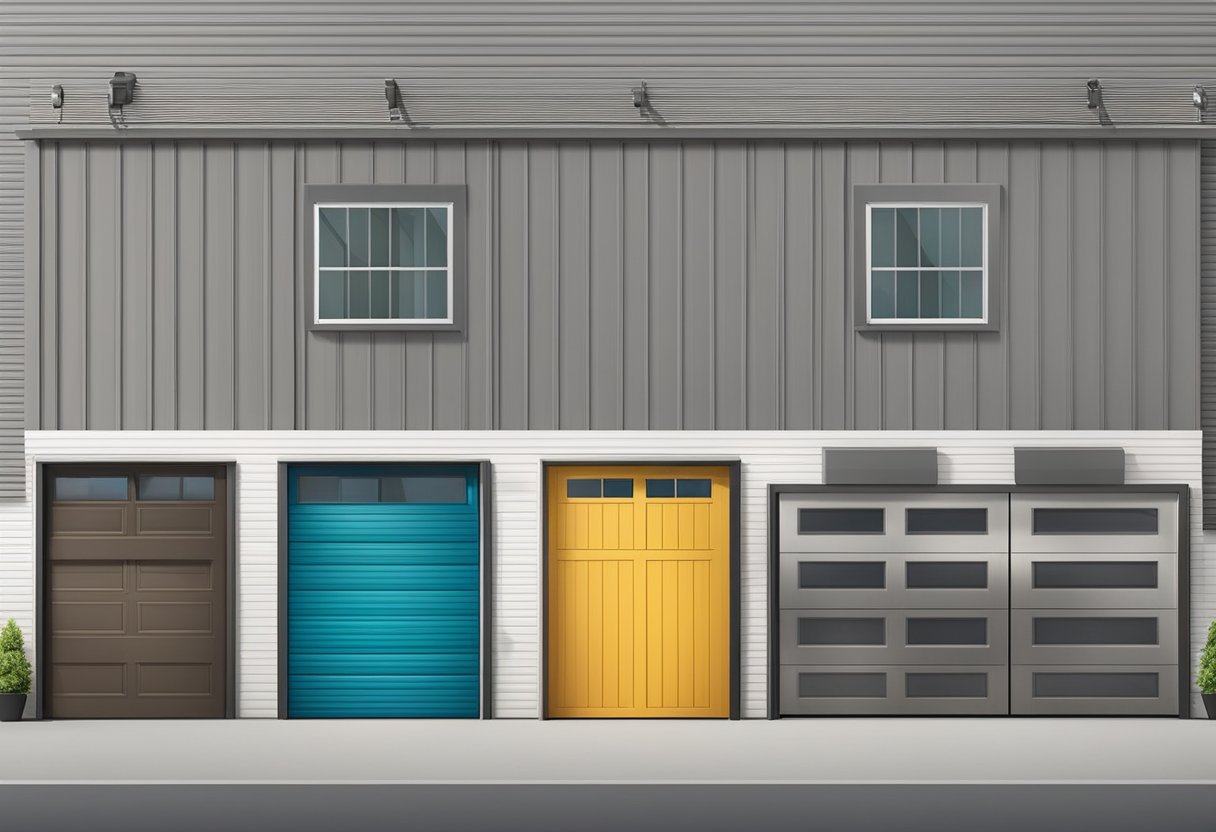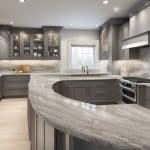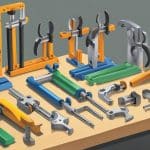Types Of Garage Doors
Garage doors come in various types, styles, and materials. Choosing the right garage door can help transform your home’s look and feel. With so many options available, it can be challenging to determine the best fit for your garage. This article will provide an overview of the different types of garage doors, including their features, advantages, and disadvantages.
Material and build quality are essential considerations when selecting a garage door. The most common materials used for garage doors include wood, steel, aluminum, and fiberglass. Each material has its unique features, such as durability, insulation, and maintenance requirements. The build quality of a garage door also plays a significant role in its performance and lifespan.
Door mechanisms and styles are other vital aspects to consider when selecting a garage door. The most common door mechanisms include sectional, roll-up, sliding, and tilt-up. The door style can also vary from traditional to modern and can be customized to suit your preferences. With this information, homeowners can make an informed decision when selecting a garage door that meets their needs and budget.
Key Takeaways
- Material and build quality are essential considerations when selecting a garage door.
- Door mechanisms and styles can vary, and customization options are available.
- Homeowners can make an informed decision by considering the features, advantages, and disadvantages of different types of garage doors.
Material and Build Quality

When it comes to garage doors, the material and build quality are crucial factors to consider. There are various materials available for garage doors, each with its own benefits and drawbacks. This section will discuss the most commonly used materials and their characteristics.
Steel Garage Doors
Steel is the most popular material for garage doors due to its durability, low maintenance, and availability in various styles. Galvanized steel is commonly used for garage doors as it is rust-resistant and provides good insulation. Steel doors can be painted to match the home’s exterior and come in textures that mimic wood. They are ideal for craftsman-style or rustic homes and offer excellent curb appeal.
Wood and Composite Doors
Wood and composite doors are popular among homeowners who want a traditional or classic look for their garage doors. Wood doors are available in different types, including cedar, redwood, and hemlock. They require regular maintenance to prevent rotting and warping. Composite doors, on the other hand, are made of a combination of wood fibers and resins and are low maintenance. They offer the same look as wood doors but are more durable and energy-efficient.
Aluminum and Glass Options
Aluminum and glass doors are modern options for garage doors. They offer a clean and sleek look and are low maintenance. Aluminum doors are lightweight and durable, making them ideal for large garage doors. Glass doors are made of tempered glass and aluminum frames and provide natural light to the garage. They are energy-efficient and offer good insulation.
Fiberglass and Vinyl Varieties
Fiberglass and vinyl doors are affordable options for homeowners who want energy-efficient and low-maintenance garage doors. Fiberglass doors are durable, lightweight, and resistant to dents and scratches. They come in various colors and finishes and can mimic the look of wood. Vinyl doors are made of PVC material and are resistant to dents, rust, and corrosion. They are energy-efficient and offer good insulation.
Other Metals and Materials
Other materials used for garage doors include copper and other metals. Copper doors are expensive but offer a unique and elegant look. They require regular maintenance to prevent tarnishing. Other metals like brass, bronze, and aluminum can be used to create custom garage doors. They offer durability and unique finishes but can be expensive.
In conclusion, choosing the right material for a garage door is essential for durability, energy efficiency, and curb appeal. Homeowners should consider their budget, maintenance requirements, and home style when selecting a garage door material.
Door Mechanisms and Styles
When it comes to garage doors, there are several types of door mechanisms and styles to choose from, each with its own set of pros and cons. In this section, we will explore the most common types of garage doors and their mechanisms.
Sectional Garage Doors
Sectional garage doors are one of the most popular types of garage doors. They are made up of several horizontal panels that are hinged together and move vertically along tracks. These doors are ideal for garages with limited ceiling space as they don’t require a lot of headroom. They are also available in a variety of styles and materials, including aluminum, steel, and wood.
Roll-Up and Roller Doors
Roll-up garage doors have multiple horizontal panels that roll up into a coil at the top of the door opening. These doors require less overhead space, making them ideal for small garages. Roller doors are similar to roll-up doors, but they are made from a single sheet of material and roll up into a drum above the door opening. These doors are ideal for garages that require maximum headroom.
Swing-Out and Sliding Variants
Swing-out doors, also known as side-hinged doors, are hinged on the sides and swing open like traditional doors. These doors are ideal for garages that require easy pedestrian access. Sliding garage doors slide open horizontally, making them ideal for garages with limited headroom. They are also available in a variety of materials, including wood, aluminum, and steel.
Tilt-Up and Canopy Types
Tilt-up garage doors are made from a single panel that tilts up and out of the way when opened. These doors require a lot of headroom and are ideal for larger garages. Canopy doors are similar to tilt-up doors, but they are made from two panels, with one panel tilting up and the other remaining in place. These doors are ideal for garages with limited headroom.
In summary, when choosing a garage door, it is important to consider the available headroom, the style of the garage door, and the material it is made from. Each type of garage door has its own unique set of pros and cons, so it is important to choose the one that best fits your needs.
Design and Customization
Garage doors are an essential part of a home’s curb appeal. They come in various designs and customization options to match different home styles and preferences. This section will explore the different ways homeowners can customize their garage doors to enhance their home’s look and feel.
Windows and Lighting
Windows and lighting are popular options for garage door customization. They add natural light to the garage and enhance the overall aesthetic appeal of the home. Homeowners can choose from different window shapes, sizes, and styles to suit their preferences. Some popular window options include rectangular, square, and arched windows. Glass garage doors are also an excellent option for homeowners who want to add natural light to their garage while maintaining privacy.
Color and Finish Customization
Color and finish customization are essential aspects of garage door design. Homeowners can choose from a wide range of colors and finishes to match their home’s exterior. Some popular color options include white, beige, black, and brown. Finishes such as wood grain, matte, and glossy are also available. It is important to note that some finishes may require more maintenance than others.
Hardware and Accessories
Hardware and accessories are the final touches that can make a garage door stand out. Homeowners can choose from different hardware options such as handles, hinges, and decorative accents to add a unique touch to their garage door. Some popular accessories include door openers, keypads, and smartphone controls. It is important to choose hardware and accessories that complement the overall design of the garage door and the home.
In conclusion, garage doors are an essential part of a home’s curb appeal. Homeowners can customize their garage doors to match their preferences and enhance their home’s look and feel. Windows and lighting, color and finish customization, and hardware and accessories are some of the popular ways homeowners can customize their garage doors.
Considerations for Homeowners
When it comes to choosing a garage door, there are a few key considerations that homeowners should keep in mind. These include security and durability, insulation and energy efficiency, compatibility with home styles, and maintenance and longevity.
Security and Durability
One of the most important factors to consider when choosing a garage door is security and durability. Homeowners should look for garage doors made from sturdy, high-quality materials such as steel or vinyl. Galvanized steel is a popular choice for its strength and resistance to rust and corrosion.
Insulation and Energy Efficiency
Insulation and energy efficiency are also important considerations for homeowners. Insulated garage doors can help keep the garage and the rest of the home warmer in the winter and cooler in the summer, which can lead to energy savings and lower utility bills. Homeowners should look for garage doors with a high R-value, which measures the insulation’s effectiveness.
Compatibility with Home Styles
When choosing a garage door, homeowners should also consider the style of their home. Colonial-style homes may look best with traditional raised-panel doors, while mid-century modern homes may benefit from sleek, contemporary designs. Carriage-style doors can add a touch of elegance and charm to any home.
Maintenance and Longevity
Finally, homeowners should consider the maintenance and longevity of their garage door. Low-maintenance materials such as vinyl can be a good choice for busy homeowners, while galvanized steel can offer long-lasting durability. Regular maintenance such as lubricating moving parts and keeping the door clean can also help extend the life of the garage door.
By keeping these considerations in mind, homeowners can choose a garage door that meets their needs and enhances the curb appeal of their home.
Buying Guide and Installation
Selecting the Right Type
When it comes to selecting the right type of garage door, homeowners have several options to choose from. The most common types of garage doors include sectional, roll-up, slide to the side, side hinged, tilt-up canopy, and tilt-up retractable.
Each type of garage door has its own set of advantages and disadvantages, so it’s important to consider factors such as headroom, limited ceiling space, and the amount of maintenance required before making a decision.
Measuring and Fitting
Before purchasing a new garage door, it’s important to measure the opening to ensure a proper fit. This includes measuring the width, height, and depth of the opening, as well as the headroom and backroom available.
Once the measurements have been taken, it’s important to choose a garage door that fits within the available space. Homeowners should also consider the color, material, and style of the garage door to ensure that it complements the overall look of their home.
Choosing a Garage Door Opener
When it comes to choosing a garage door opener, homeowners have several options to choose from. The most common types of garage door openers include chain drive, belt drive, screw drive, and direct drive.
Each type of garage door opener has its own set of advantages and disadvantages, so it’s important to consider factors such as noise level, speed, and durability before making a decision.
Overall, selecting the right type of garage door and opener is an important decision that requires careful consideration. By following this buying guide and installation tips, homeowners can ensure that they make the best possible choice for their needs and budget.






